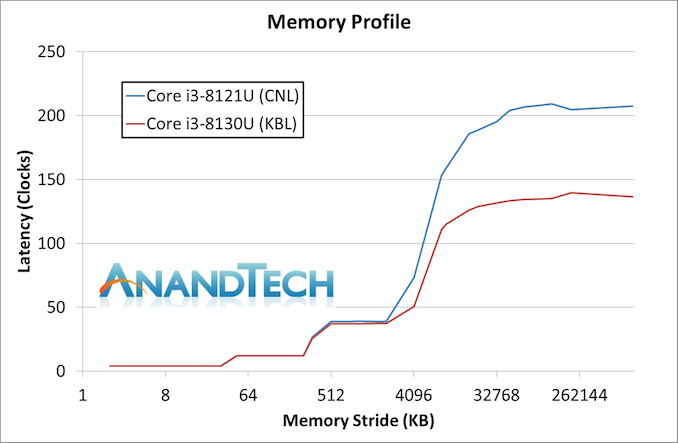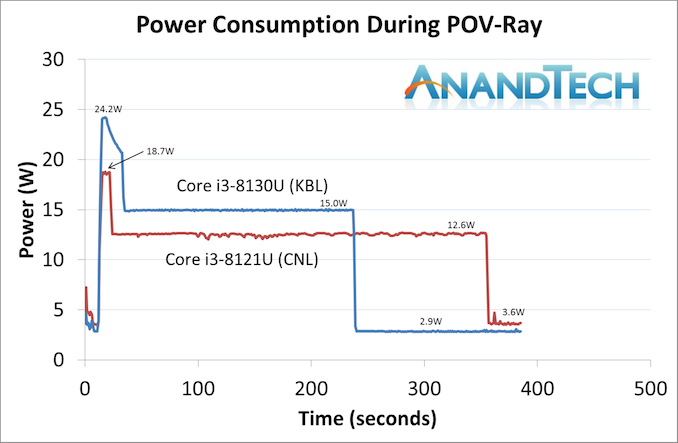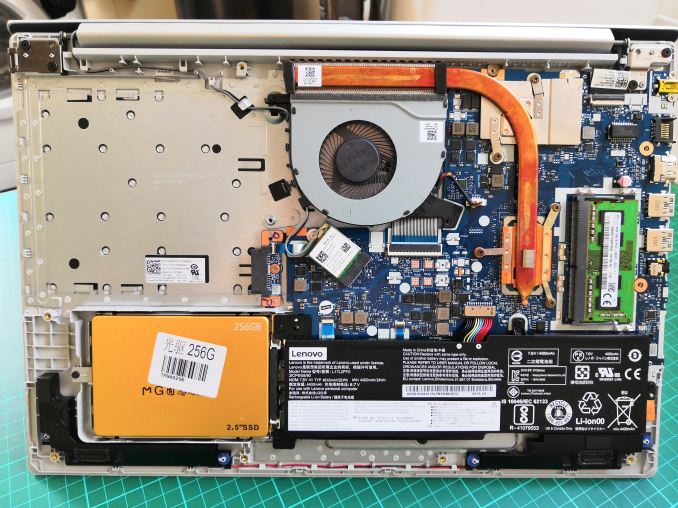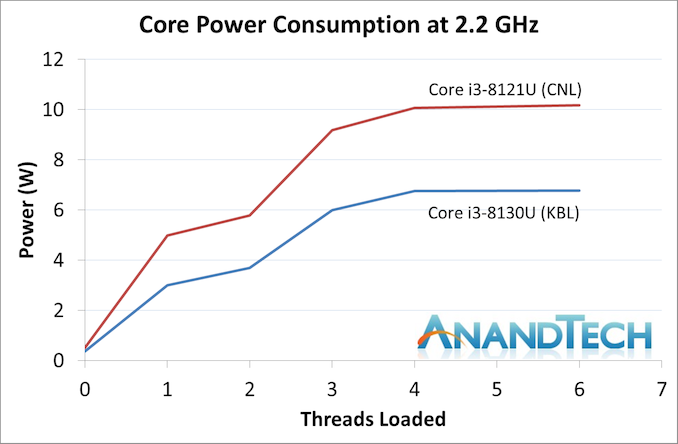Intel's 10nm Cannon Lake and Core i3-8121U Deep Dive Review
by Ian Cutress on January 25, 2019 10:30 AM ESTCPU Performance: Memory and Power
Memory
With the same memory setup as the standard Skylake-style core, without any other improvements, we should expect Cannon Lake to perform exactly similar. Here’s a recap of the memory configuration:
| Memory Comparison | ||
| Skylake Desktop | Cannon Lake | |
| L1-D Cache |
32 KiB/core 8-way |
32 KiB/core 8-way |
| L1-I Cache |
32 KiB/core 8-way |
32 KiB/core 8-way |
| L2 Cache |
256 KiB/core 4-way |
256 KiB/core 4-way |
| L3 Cache |
2 MiB/core 16-way |
2 MiB/core 16-way |
| L3 Cache Type | Inclusive | Inclusive |
For this test we put our Cannon Lake and Kaby Lake processors through our Memory Latency Checker test. Both systems had turbo modes disabled, forcing them to run at 2.2 GHz for parity and a direct microarchitecture comparison.
In this instance we see very little different between the two through the caches of the chip. Up to about 2MiB, both chips perform practically identical. Beyond this however, going out to main memory, there is a big discrepancy between the Kaby Lake and the Cannon Lake processor. In essence, accessing Cannon Lake main memory has an additional 50% latency.
At first we thought this was a bug. For both systems to have dual channel memory and running DDR4-2400, something had to be wrong. We double checked the setups – both systems were running in dual channel mode, giving the same memory bandwidth. The Cannon Lake processor was running at DDR4-2400 17-17-17, whereas the Kaby Lake system was at DDR4-2400 16-16-16 (due to memory SPD differences), which isn’t a big enough change to have such a big difference. The only reason we can come up with is that the memory controller on Cannon Lake must have additional overhead from the core to the memory controller – either a slower than expected PLL or something.
Power
Measuring the power of these thermally limited systems is somewhat frustrating in that we are at the whims of the quality of silicon at play. Bad silicon can get hotter faster, causing thermal throttling, or it depends on how the systems are set up for the peak power numbers. We use AIDA’s power monitoring tool to give us the power numbers for the CPUs during our POV-Ray test.
If you saw our How Intel Measures TDP article, you may be familiar with the concept of Power Limits. Intel processors have several power limits set in firmware – these values are set by the system manufacturer, and Intel provides ‘guidelines’. The two key values are Power Limit 1 (PL1), which describes a steady state scenario, and Power Limit 2 (PL2) which describes a turbo scenario. The reason why the system manufacturer gets control of these is because they might put a high wattage processor into a small form factor system, and need to manage performance – this is why we sometimes see a Core i7 be outperformed by a Core i5 in the same system design.
In most cases, PL1 is set to the TDP of the processor – in this case, it should be 15W. As shown on the graph above, this is true for our Core i3-8130U system, which shows a steady state power consumption of 15.0W. The Cannon Lake processor however only peaks at 12.6W.
PL2, the turbo power of the processor, can also be determined. For the Kaby Lake processor, we see a peak of 24.2 W, while the Cannon Lake has a turbo only of 18.7 W. We see that the turbo time period for the Cannon Lake processor is also much shorter, leading to a PL1 / steady state power much sooner.
Part of this is because we are pitting the Cannon Lake laptop against the Kaby Lake mini-PC. That being said, the Cannon Lake laptop is a beefy 15.6-inch unit, and has cooling for both the CPU and the discrete RX540 graphics, which isn’t doing much during this test except showing a basic 2D display.
That is arguably a lot more cooling than the mini-PC provides, plus we are cooling it with additional fans. These settings are more a function of both Lenovo doing what it wants to in firmware that we can’t change, but also the chip as engineered.
We can also calculate some level of efficiency here. By taking the area under the graph and correcting for the base line power (2.9 W on KBL, 3.6 W on CNL), we can calculate the total power consumed during the test. We get the following:
- Core i3-8121U (CNL) consumes 867 mWh
- Core i3-8130U (KBL) consumes 768 mWh
So this means that Cannon Lake is slower in AVX2 frequency, consumes more power, and scores 25% less in POV-Ray (see previous pages). That’s damning for the design.
To further look into this data, we disabled the turbo modes on both processors and ran our POV-Ray workload adjusting the number of threads being loaded and then measured the power consumption. In this scenario we are running at the same frequency, measuring the steady state power, and are thus at the whims of both the voltage set on both processors and the efficiency. Our tool also lets us measure the power of just the cores, so we’ll plot core power against threads loaded.
If this graph was the definitive graph, it shows that Cannon Lake is vastly inefficient (at 2.2 GHz) compared to Kaby Lake.














129 Comments
View All Comments
BigMamaInHouse - Friday, January 25, 2019 - link
Thank you for your Great reviews.Look like we should not ecpect much from those new 10nm CPU's for cunsumers for new future, maybe in Q1 2020 with 10++ gen.
2019 going to be on AMD's Favor!.
jaju123 - Friday, January 25, 2019 - link
12 or 16 core Ryzen with a 13% IPC increase, at equivalent power to the i9-9900k is not going to go well for Intel. Seems like they'll be able to compete with the AMD processors of 2019 around late 2020 at the earliest.ZolaIII - Friday, January 25, 2019 - link
Take a look at the Spec 2006 benchmark and make the comparation to A76 (Snapdragon 855) it beats this Intel SKU (@2.2 GHz) In most cases with only half the power used. When SVE NEON SIMD lies in CISC is doomed.Gondalf - Friday, January 25, 2019 - link
Unfortunately we don't know how perform AMD new cpus, only cherry picked results nothing more.Even less we know about power consumption. Are we certain AMD 7nm cores will are winner over 12nm ones?? AMD is unhappy about clock speed for example, so the IPC advantage will be likely vanished.
IMO AMD is painting a too bright future to be trusted. TSMC process is not perfect at all, instead of Nvidia should be on it right now.
levizx - Saturday, January 26, 2019 - link
Rubbish written in garbled words.KOneJ - Sunday, January 27, 2019 - link
What exactly are you trying to babble about here?Valantar - Sunday, January 27, 2019 - link
Lying about future products is grounds for lawsuits from shareholders (and possible criminal charges many places), so that's quite unlikely. We do have one indication of power draw from Zen2, from the live Cinebench demo where an 8-core Zen2 chip matched the 9900K's score at ~50W lower power. Of course we don't know how clocks will scale, nor the clock speed that test was run at, and it's relatively well established that Cinebench is a workload where AMD does well. Still, TSMC 7nm is proven good at this point, with several shipping large-scale SKUs on it (Apple A12, A12X, among others). Even if these are all mobile low-power chips, they're very high performance _and_ low power, which ought to fit Zen2 well. Also, the Cinebench score matching the 9900K means that either IPC has improved massively, SMT scaling on Zen2 is ~100%, or clocks are quite high. Likely it's a mix of all three, but they wouldn't reach that score without pretty decent clocks.Samus - Thursday, January 31, 2019 - link
Ignoring any Zen IPC improvement whatsoever, process improvements alone this year would make them competitive with Intel going forward. All they need to do is ramp up the clock frequency a bit without a TDP penalty and they have an automatic win...Makste - Saturday, March 6, 2021 - link
Lol😆Vegajf - Friday, January 25, 2019 - link
Icelake desktop will be out 3q 2020 from what I hear. We will have another 14nm refresh before then though.